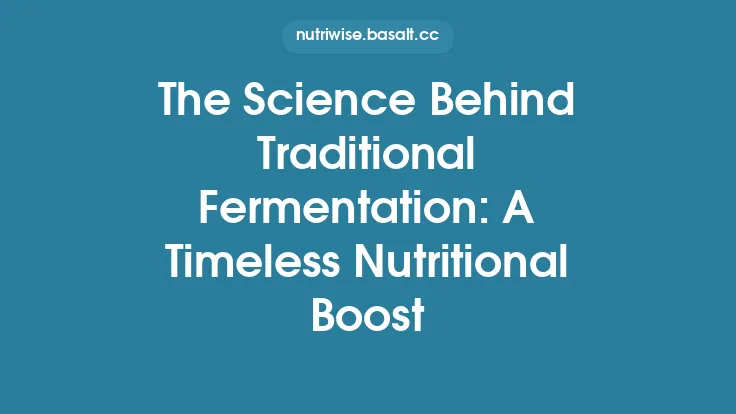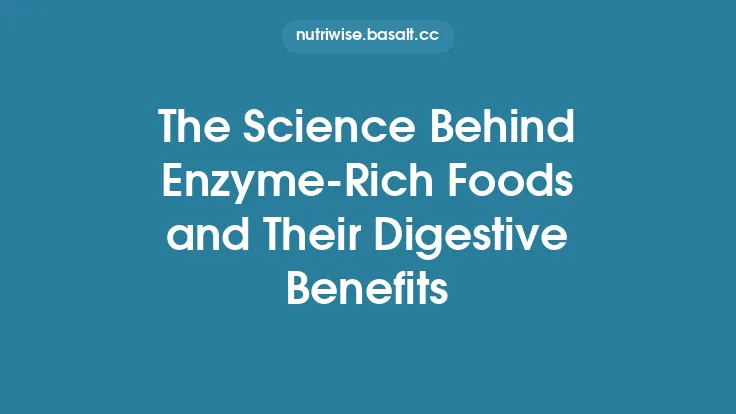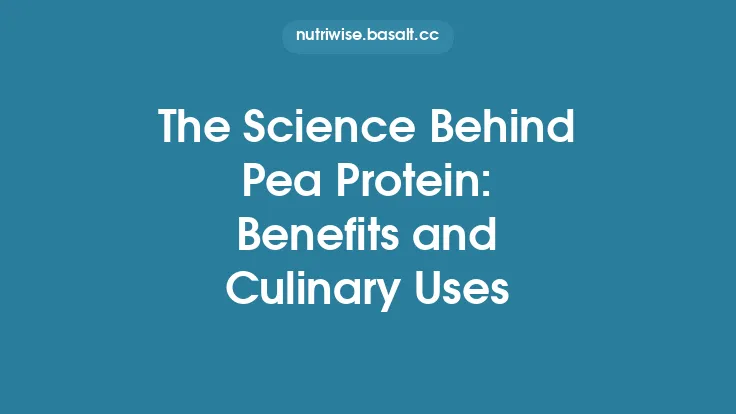Fermentation is one of humanity’s oldest food‑preservation techniques, yet the microscopic drama that unfolds within a jar or vat remains a marvel of modern science. At its core, fermentation is a metabolic partnership between food substrates and a diverse community of microorganisms—primarily bacteria, yeasts, and occasionally molds—that convert sugars, proteins, and lipids into a suite of organic acids, gases, and bioactive compounds. This transformation not only extends shelf life but also reshapes the nutritional landscape of the food, creating flavors, textures, and health‑promoting properties that are impossible to achieve through conventional cooking alone. Understanding the science behind these processes provides a foundation for both culinary innovation and evidence‑based nutrition.
Understanding Fermentation: A Biological Overview
Fermentation can be defined as an anaerobic (or micro‑aerophilic) metabolic pathway in which microorganisms derive energy from the breakdown of organic compounds without the complete oxidation that characterizes aerobic respiration. In the context of food, the most common substrates are carbohydrates—glucose, fructose, sucrose, and complex polysaccharides such as starch or cellulose. When these sugars are metabolized, the end‑products vary according to the organism’s enzymatic repertoire and the environmental conditions, leading to distinct fermentation types:
- Lactic acid fermentation – predominately carried out by lactic acid bacteria (LAB) that convert glucose to lactic acid, lowering pH and creating a tangy flavor.
- Acetic acid fermentation – typically performed by acetic acid bacteria (AAB) that oxidize ethanol to acetic acid, imparting a sharp, vinegary note.
- Ethanol fermentation – driven by yeasts that convert sugars to ethanol and carbon dioxide, the basis for alcoholic beverages and leavened breads.
- Propionic and butyric fermentations – less common in everyday culinary practice but crucial in certain cheese ripening and traditional fermented meats.
These pathways are not mutually exclusive; many fermented foods host a succession of microbial groups that sequentially dominate, each reshaping the substrate for the next wave of activity.
Key Microbial Players in Food Fermentation
The microbial consortium that drives fermentation is highly diverse, yet a few taxonomic groups dominate the culinary landscape:
| Group | Representative Genera | Primary Metabolic Signature |
|---|---|---|
| Lactic Acid Bacteria (LAB) | *Lactobacillus, Leuconostoc, Pediococcus, Lactococcus* | Homolactic (mostly lactic acid) or heterolactic (lactic acid + CO₂ + ethanol/acetate) |
| Acetic Acid Bacteria (AAB) | *Acetobacter, Gluconobacter* | Oxidation of ethanol to acetic acid (aerobic) |
| Yeasts | *Saccharomyces, Candida, Kluyveromyces* | Ethanol + CO₂ production; some also produce glycerol, organic acids |
| Molds (occasionally) | *Penicillium, Aspergillus* | Proteolysis and lipolysis; production of flavor volatiles |
Each genus possesses a unique set of enzymes that dictate which substrates are utilized and which metabolites accumulate. For instance, *Lactobacillus plantarum harbors a robust phosphoketolase pathway, enabling it to ferment pentoses and hexoses simultaneously, while Leuconostoc mesenteroides* excels at producing diacetyl, a buttery‑flavored compound.
Metabolic Pathways: From Sugars to Acids and Beyond
The central metabolic hub of most food fermentations is glycolysis, the ten‑step enzymatic conversion of glucose to pyruvate. From pyruvate, divergent routes emerge:
- Homolactic Fermentation – Pyruvate is reduced directly to lactic acid by lactate dehydrogenase (LDH), regenerating NAD⁺ for continued glycolysis. This pathway yields two moles of lactic acid per mole of glucose, dramatically dropping pH.
- Heterolactic Fermentation – Involves the phosphoketolase pathway, where pyruvate is split into lactic acid, ethanol (or acetate), and CO₂. The mixed acid profile contributes to complex flavor development.
- Ethanolic Fermentation – Yeasts decarboxylate pyruvate to acetaldehyde (via pyruvate decarboxylase) and then reduce it to ethanol (via alcohol dehydrogenase), releasing CO₂ as a by‑product.
- Acetic Acid Production – AAB oxidize ethanol to acetaldehyde and then to acetic acid using membrane‑bound dehydrogenases that require oxygen as the terminal electron acceptor.
Beyond these primary routes, secondary metabolic pathways generate a plethora of bioactive compounds: exopolysaccharides (EPS) that improve texture, bacteriocins that inhibit spoilage organisms, and vitamins (e.g., B‑group vitamins) synthesized de novo by certain LAB strains.
Biochemical Transformations and Nutrient Enhancement
Fermentation reshapes the nutritional profile of food in several measurable ways:
- Increased Bioavailability of Minerals – Phytic acid, a common anti‑nutrient in grains and legumes, is hydrolyzed by phytases produced by many LAB, liberating bound iron, zinc, and calcium.
- Synthesis of B‑Vitamins – Certain *Lactobacillus and Bifidobacterium* species synthesize riboflavin (B₂), folate (B₉), and cobalamin (B₁₂) during growth, enriching the final product.
- Protein Hydrolysis – Proteolytic enzymes break down complex proteins into peptides and free amino acids, enhancing digestibility and generating flavor precursors such as glutamate.
- Reduction of Harmful Compounds – Fermentation can degrade nitrates, mycotoxins, and biogenic amines, improving safety.
- Generation of Short‑Chain Fatty Acids (SCFAs) – While SCFAs are more commonly associated with colonic fermentation, certain food fermentations produce acetate, propionate, and butyrate analogs that may exert systemic metabolic effects.
Collectively, these changes contribute to the “functional” nature of many fermented foods, positioning them as vehicles for delivering health‑promoting nutrients beyond their raw counterparts.
The Role of pH, Redox, and Environmental Factors
Microbial activity is tightly regulated by physicochemical parameters:
- pH – As lactic acid accumulates, the environment becomes increasingly acidic. Most pathogenic bacteria cannot survive below pH 4.0, whereas many LAB thrive down to pH 3.0, creating a self‑reinforcing safety barrier.
- Redox Potential (Eh) – The oxidation‑reduction state influences which metabolic pathways are favored. Low Eh (more reducing conditions) promotes anaerobic pathways (e.g., lactic acid production), while higher Eh (more oxidizing) enables aerobic oxidation of ethanol to acetic acid.
- Temperature – Each microbial group has an optimal growth range (e.g., mesophilic LAB: 30‑40 °C; psychrotrophic LAB: 10‑20 °C). Temperature modulates enzyme kinetics, influencing the rate of acid production and flavor development.
- Water Activity (a_w) – Fermentation typically occurs in high‑moisture environments, but gradual water loss can concentrate solutes, affecting microbial viability and metabolic rates.
- Oxygen Availability – Strict anaerobes (e.g., many LAB) are inhibited by oxygen, whereas AAB require it. Controlled exposure to air can be used to steer the fermentation toward desired acid profiles.
Understanding and manipulating these variables allows producers to fine‑tune the balance between safety, texture, and sensory attributes without resorting to artificial preservatives.
Microbial Succession and Community Dynamics
Fermented foods rarely host a static microbial population. Instead, they undergo a predictable succession:
- Early Phase – Pioneer organisms, often facultative anaerobes such as *Enterobacteriaceae* or certain yeasts, rapidly consume readily available sugars and oxygen, lowering redox potential.
- Intermediate Phase – As oxygen is depleted and pH drops, obligate anaerobes—primarily LAB—take over, dominating the ecosystem and producing lactic acid.
- Late Phase – In some fermentations, acid‑tolerant AAB or secondary LAB species emerge, converting residual ethanol to acetic acid or generating additional flavor compounds.
This dynamic is governed by competitive interactions (e.g., bacteriocin production), metabolic cross‑feeding (e.g., yeast‑derived vitamins supporting LAB growth), and environmental feedback loops. Modern metagenomic sequencing has revealed that even seemingly simple fermentations can harbor dozens of distinct strains, each contributing subtly to the final organoleptic profile.
Health Implications of Fermented Foods
The health benefits attributed to fermented foods stem from both the live microorganisms they contain and the biochemical changes they undergo:
- Probiotic Effects – Viable LAB and yeasts can transiently colonize the gut, modulating the resident microbiota, enhancing barrier function, and interacting with the immune system. Specific strains have been shown to reduce the incidence of antibiotic‑associated diarrhea and to alleviate symptoms of irritable bowel syndrome.
- Prebiotic Contributions – Fermentation often generates oligosaccharides and EPS that serve as substrates for beneficial gut microbes, fostering a symbiotic environment.
- Anti‑Inflammatory and Antioxidant Activity – Bioactive peptides released during proteolysis can inhibit angiotensin‑converting enzyme (ACE), potentially lowering blood pressure. Additionally, phenolic compounds may be liberated from plant matrices, enhancing antioxidant capacity.
- Metabolic Modulation – SCFAs produced during fermentation can influence glucose homeostasis, lipid metabolism, and satiety signaling via G‑protein‑coupled receptors (e.g., GPR41/43).
It is important to note that the magnitude of these effects depends on the viability of the microorganisms at the point of consumption, the dose ingested, and individual host factors such as existing gut microbiota composition.
Fermentation in the Human Gut vs. Food Fermentation
While both processes involve microbial metabolism of carbohydrates, there are key distinctions:
- Substrate Complexity – In the gut, microbes encounter a heterogeneous mixture of dietary fibers, resistant starches, and host‑derived glycans, whereas food fermentation typically starts with a defined carbohydrate source.
- Microbial Diversity – The gut microbiome comprises hundreds of species across multiple phyla (Firmicutes, Bacteroidetes, Actinobacteria, etc.), whereas food fermentations are often dominated by a handful of functional groups.
- Environmental Conditions – The gut maintains a relatively constant temperature (≈37 °C), pH gradient (stomach to colon), and anaerobic environment, whereas food fermentations can be engineered across a broader range of conditions.
- Functional Outcomes – Gut fermentation primarily yields SCFAs that serve as energy sources for colonocytes, whereas food fermentation aims to preserve, flavor, and enhance nutritional value.
Understanding these differences helps clarify why certain probiotic strains thrive in fermented foods but may not persist long‑term in the gastrointestinal tract, and vice versa.
Modern Analytical Techniques in Fermentation Science
Advances in analytical technology have transformed our ability to dissect fermentation processes:
- Metagenomics & Metatranscriptomics – High‑throughput sequencing provides a snapshot of community composition and functional gene expression, revealing which metabolic pathways are active at each stage.
- Metabolomics (LC‑MS, GC‑MS, NMR) – Comprehensive profiling of small molecules captures the evolving flavor and bioactive compound landscape, enabling correlation with sensory attributes.
- Real‑Time pH and Redox Monitoring – Integrated sensors allow precise control of fermentation kinetics, facilitating scale‑up from laboratory to industrial production.
- CRISPR‑Based Strain Engineering – Targeted genome editing can enhance desirable traits (e.g., increased folate synthesis) while attenuating undesirable ones (e.g., biogenic amine production).
These tools not only accelerate product development but also provide the scientific rigor needed to substantiate health claims associated with fermented foods.
Future Directions: Engineering Beneficial Ferments
The frontier of fermentation science lies at the intersection of traditional knowledge and synthetic biology:
- Designer Consortia – By assembling defined mixtures of complementary strains, researchers can program predictable flavor trajectories and health outcomes.
- Functional Fortification – Engineered microbes capable of synthesizing omega‑3 fatty acids, vitamin D, or novel antioxidants could turn everyday fermented foods into nutraceutical platforms.
- Precision Fermentation – Tailoring fermentation parameters to individual microbiome profiles may enable personalized functional foods that address specific health concerns.
- Sustainable Production – Leveraging waste streams (e.g., vegetable peels) as substrates for fermentation can reduce food waste while generating value‑added probiotic products.
As regulatory frameworks evolve to accommodate these innovations, the scientific community must continue to elucidate the mechanisms by which beneficial bacteria transform food, ensuring that new technologies retain the safety, efficacy, and sensory appeal that have made fermentation a timeless culinary art.





